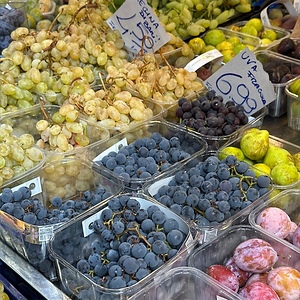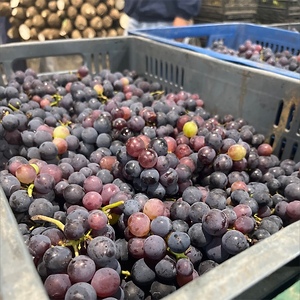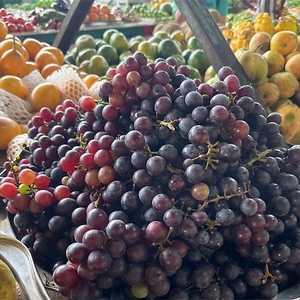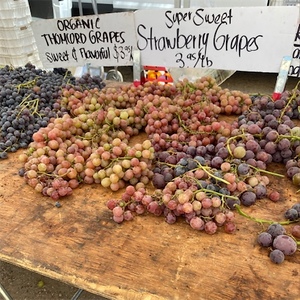

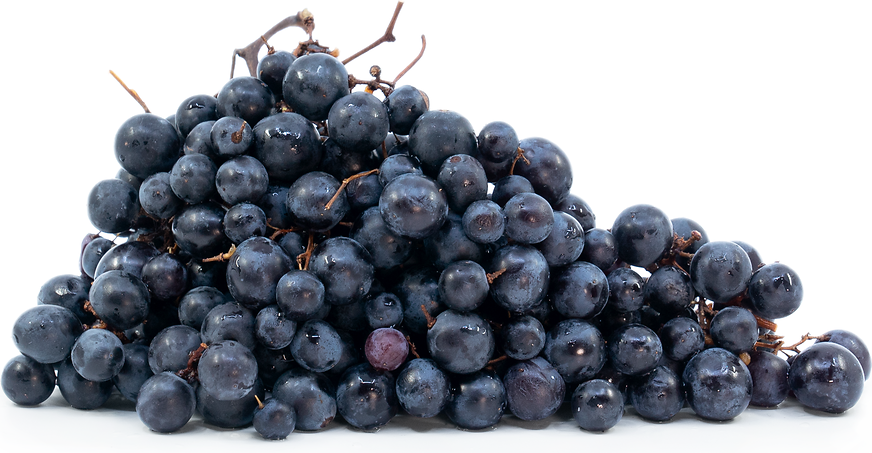
Strawberry Grapes
Estimated Inventory, lb : 0
Description/Taste
Strawberry grapes grow in semi-loose cascading bunches attached to dark brown, woody, and fibrous branching stems. Each grape averages 1 to 2 centimeters in diameter, and several sizes of grapes can be found throughout the bunch, maturing at different periods. Strawberry grapes typically have a round to oval shape, and the skin is smooth, taut, firm, and thick, showcasing a dark purple, almost black hue. The surface is also covered in a silvery blue-grey bloom, a natural, protective layer preventing the grapes from losing moisture. Underneath the surface, the flesh has a translucent pale green hue and a gelatinous, aqueous, tender, and succulent nature. The flesh also encases several large brown tapered crunchy seeds that release a bitter flavor if consumed. Strawberry grapes have astringent sour skin combined with sweet, musky, wine-like nuances and a subtle candied, fruity sweetness that lingers on the palate.
Seasons/Availability
Strawberry grapes are available in the late summer through fall.
Current Facts
Strawberry grapes are botanically a part of the Vitis genus and are a hybrid variety belonging to the Vitaceae family. The grapes grow on deciduous, climbing vines extending anywhere from 4 to 8 meters and are a popular variety for growing against walls on espaliers. Strawberry grapes were named for their fruity, berry-like taste and are known by several names worldwide, including Uva Fragola, Strawberry Vine grapes, Isabell, Isabella, Fragolina, Fragolino, and Fragola. The mid-season variety is favored by home gardeners for its disease resistance, large crops, extreme weather tolerance, and reliable harvests of sweet-tasting grapes. Strawberry grapes are grown on a small scale as table grapes and are primarily consumed fresh, cooked, or fermented into wine.
Nutritional Value
Strawberry grapes are a source of vitamin C to strengthen the immune system while boosting collagen production, vitamin A to maintain healthy organ functioning, and potassium to balance fluid levels within the body. The grapes also provide iron to develop the protein hemoglobin for oxygen transport through the bloodstream, vitamin K for faster wound healing, and other nutrients, including manganese, B vitamins, copper, and fiber. The pigmented grapes contain anthocyanins, natural compounds that give the grapes their dark coloring and have antioxidant-like properties to protect the cells against the damage caused by free radicals.
Applications
Strawberry grapes have a sweet flavor suited for fresh preparations. The variety is traditionally consumed as a table grape and is eaten straight out of hand, savored for its fruity, sweet, and refreshing taste. Strawberry grapes can also be served on cheese boards as a fresh element, tossed into salads, mixed into fruit bowls, or stirred into creamy dips and spreads. The grape's compact nature allows them to be sliced and used as an edible decoration on cakes, layered over tarts, or pressed into juice and used to flavor ice cream. Strawberry grapes can also be layered into parfaits, simmered into jam, jellies, and sauces, or infused into syrups for desserts, teas, and cocktails. In Italy, Strawberry grapes are popularly fermented into wine or infused into a sweet liquor. They are also baked into seasonal focaccia bread known as schiacciata con l'uva. The grape-filled bread is commonly made during the harvest season and is created as a local delicacy. Strawberry grapes pair well with cheeses such as brie, gouda, and goat, fruits including apples, pears, and melons, seafood, and herbs such as mint, rosemary, and parsley. Unwashed Strawberry grapes will keep up to one week when stored in a perforated plastic bag in the refrigerator.
Ethnic/Cultural Info
Strawberry grapes are known as Uva Fragola in Italy and are cultivated in home gardens throughout northern and central regions, including Veneto, Trentino, and Tuscany. The grapes are grown as a table grape, but they are also most famously known for their use in the controversial Fragolino wine. Fragolino was a name created to roughly mean "little strawberry," and the wine is similar to a type of sparkling rose. Fragolino is illegal to sell in Europe, and the wine is strictly banned from commercial retailers. There are several legends surrounding the ban on the wine. Some experts believe Strawberry grapes, also known as Isabella in the United States, were blamed for introducing the phylloxera outbreak among European vineyards, leading to the mass destruction of local wine-making grapevines. This caused decision-makers to crack down on the cultivation of the variety to help preserve the remaining European grapevines. Another legend surrounding the prohibited wine is due to its fermentation process. Scientists noticed that fermenting Strawberry grapes sometimes leads to the production of methanol and tannins, which in high levels, are toxic. Despite the controversy, Fragolino is still produced in Italy among locals and is allowed to be made for personal, home use. Select bars in Italy, especially in Veneto, also serve unmarked bottles of Fragolino to consumers under the table as a secret item.
Geography/History
Strawberry grapes are believed by experts to be an interspecific cross between a Vitis labrusca and a Vitis vinifera grape. Much of the history of the variety is unknown or heavily debated, but Strawberry grapes were thought to have been first discovered growing in a garden in South Carolina around 1816. Throughout the 19th century, Europe suffered from a phylloxera outbreak, microscopic fly-like insects that destroyed most of the grapevines cultivated in wine-producing regions. American Vitis labrusca varieties, including Strawberry grapes, were resistant to phylloxera and were exported to Europe during this time. Despite their pest resistance, it was later realized that the phylloxera outbreak in Europe was actually traced back to the roots of the American grape species. This discovery led European growers to dislike American varieties, blaming them for destroying European grapes. Many European countries also began to ban varieties grown on American rootstock, forcing growers to graft American grapes onto European Vitis vinifera rootstocks to prevent future outbreaks. Before the outbreak, Strawberry grapes were extensively cultivated in France and Italy, increasing in popularity among consumers. Even with increased demand, the grapes were eventually banned by officials from France, and in Italy, the grapes were localized to home gardens. Growers in the United Kingdom and the United States recognized the consumer desire for Strawberry grapes and began commercially cultivating the variety on a small scale in the 21st century. Today Strawberry grapes are grown worldwide and are a specialty variety sold through local markets in Europe, especially in Italy, Ukraine, England, and Portugal, New Zealand, Australia, Brazil, India, Japan, and the United States.
Recipe Ideas
Recipes that include Strawberry Grapes. One
| Italian Food Forever |
|
Schiacciata Con L'uva Focacia with Harvest Grapes |



